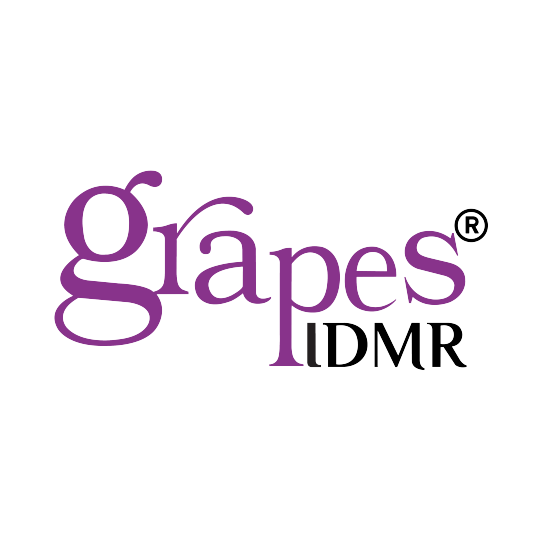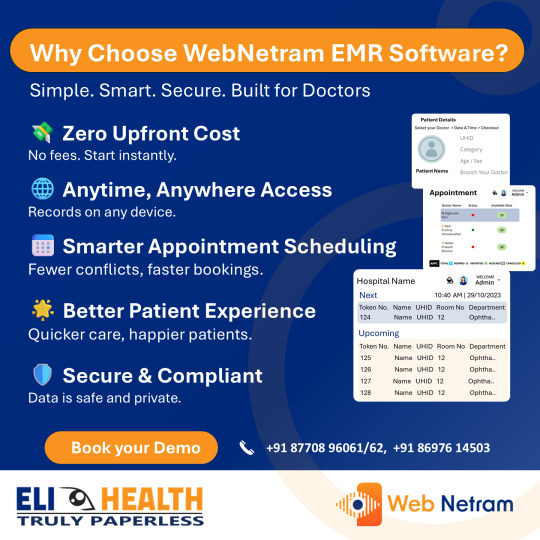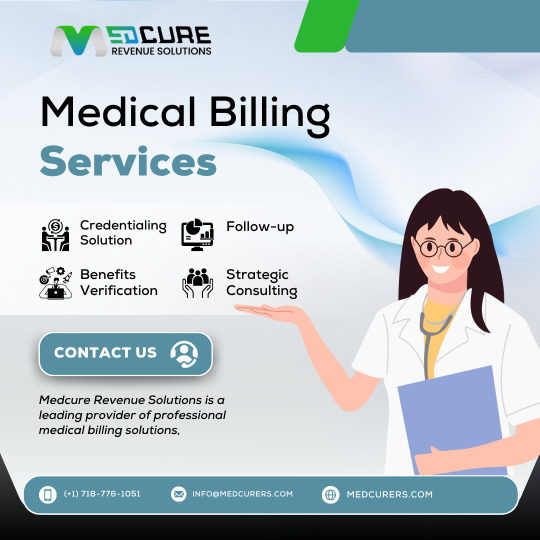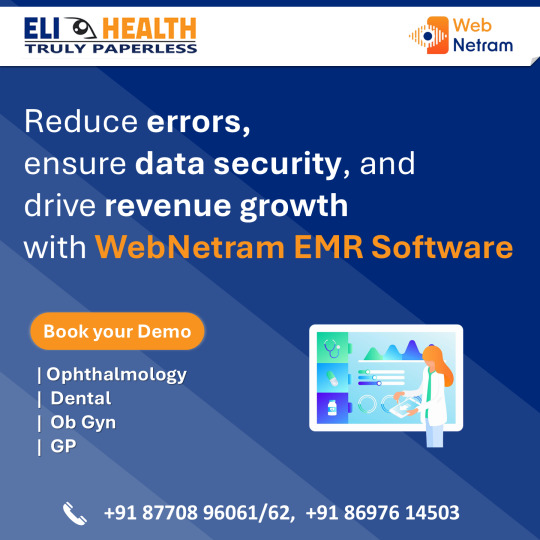#EMRsoftware
Explore tagged Tumblr posts
Photo

the Best Electronic Health Record Software in India | grapes idmr (on Wattpad) https://www.wattpad.com/story/385498617-the-best-electronic-health-record-software-in?utm_source=web&utm_medium=tumblr&utm_content=share_myworks&wp_uname=jeraldnepoleon The healthcare industry is undergoing a significant transformation, with technology playing a pivotal role in improving patient care, increasing efficiency, and reducing operational costs. One of the most important innovations in this revolution is the Best Electronic Health Record software, which has become a cornerstone for modern healthcare management. Among the various solutions available, Grapes IDMR, developed by Grapes Innovative Solutions, stands out as one of the most comprehensive and efficient Electronic Health Record (EHR) software in India...
#emrsoftware#grapesidmr#healthcare#hmssoftware#hospitalmanagementsoftware#jeraldnepoleon#software#books#wattpad#amwriting
2 notes
·
View notes
Text
CMS now mandates hospitals to display actual procedure costs instead of estimates. Learn how this impacts ophthalmology practices and how a specialty EHR simplifies price transparency compliance.
#ophthalmology#ehr solution#emrsoftware#usa news#us healthcare#us health system#one big beautiful bill act#medical billing#doctors#surgeon
1 note
·
View note
Text
Electronic Medical Records Solution for Therapists | Turbo PT
TurboPT offers a cutting-edge Electronic Medical Records (EMR) system designed specifically for physical, occupational, and speech therapists. With features like ChatGPT-powered AI documentation, customizable templates, and seamless integration with billing and scheduling, TurboPT streamlines clinic operations. The platform ensures HIPAA-compliant security, mobile optimization, and real-time analytics, empowering therapists to enhance patient care and practice efficiency. Experience the next generation of EMR solutions tailored for therapy professionals.
0 notes
Text
#OpenEMR#HealthIT#EMRSoftware#EHR#MedicalTechnology#PatientManagement#ePrescriptions#HealthcareSecurity#ClinicalSoftware#QiabenTech
0 notes
Text
Why EMR Software Is the Backbone of Modern Healthcare
EMR software simplifies the way clinics and hospitals manage patient information. Designed to digitize and streamline the healthcare workflow, it reduces paperwork, minimizes errors, and ensures easy access to clinical data. With EMR software, medical professionals can make quick decisions based on real-time patient histories, prescriptions, and lab reports. This article explains how EMR software benefits clinics and hospitals by saving time, enhancing accuracy, and ensuring data security. Discover how your facility can improve service quality, patient care, and operational efficiency with a reliable EMR system tailored to meet today’s healthcare demands.
Understanding EMR Software: The Digital Record System
EMR software stands for Electronic Medical Records software a digital solution that allows healthcare professionals to maintain and retrieve patient records electronically. Instead of storing data in physical files, all information is kept in a structured, searchable system. From personal details to previous visits, diagnoses, and treatments, everything is recorded systematically and can be accessed with just a few clicks.
This shift from manual to digital systems is not just about convenience; it’s about creating a safer, more accurate, and faster healthcare environment. EMR software helps doctors and nurses deliver better care by providing instant access to reliable and updated medical information.
The Core Functions of EMR Software
EMR software works as a central nervous system for healthcare facilities. Let’s break down the core functions:
1. Clinical Documentation:
Every patient interaction is recorded in real-time. This includes symptoms, examination notes, diagnoses, and treatment plans. The system stores it all for future reference.
2. Medication and Allergy Tracking:
Prescriptions and allergy alerts are automatically generated to avoid adverse drug interactions, ensuring patient safety.
3. Lab Test Integration:
Once a test is completed, results are automatically linked to the patient’s profile, eliminating delays and miscommunication between departments.
4. Appointment Scheduling:
From first visits to follow-ups, all appointments can be managed within the software, often with automated reminders.
5. Billing and Insurance:
Some EMR systems integrate with billing and insurance systems, making claim submissions and payments smoother and error-free.
Benefits of EMR Software That Every Hospital Should Know
Time Efficiency:
Manual data entry and retrieval are time-consuming. EMR software significantly speeds up charting, prescription writing, and report generation.
Accuracy and Data Integrity:
Handwritten notes can be hard to read. EMR entries are standardized, legible, and error-checked, making the entire workflow more reliable.
Consistent Patient Care:
With full access to patient histories, doctors can avoid repeating tests and ensure treatments are based on accurate data.
Better Communication:
Whether it's between doctors, lab staff, or the pharmacy, EMR software ensures everyone stays updated with real-time patient data.
Improved Patient Experience:
Shorter wait times, accurate billing, quick reports, and follow-up reminders improve how patients perceive and interact with the hospital.
Security in EMR Software: Protecting Patient Data
Security is a critical component in EMR software, especially when handling sensitive patient information. To ensure data protection, most EMR systems incorporate encrypted data storage, which shields records from unauthorized access. Additionally, role-based access control allows only authorized personnel to view or edit specific types of data, ensuring privacy and operational control. Many platforms also feature automatic backups, minimizing the risk of data loss due to hardware failure or unexpected outages. Another important layer of security is audit logging, which records every access and action taken on patient files, enhancing transparency and accountability. These safeguards are vital in helping clinics and hospitals comply with healthcare regulations and patient data protection laws.
EMR vs. EHR: What's the Difference?
While EMR (Electronic Medical Records) and EHR (Electronic Health Records) are often used interchangeably, they have distinct purposes. EMR software is typically used within a single clinic or hospital to store and manage internal patient records. It is ideal for streamlining in-house workflows and maintaining organized documentation. On the other hand, EHR systems are more expansive, enabling data sharing across multiple healthcare facilities. This makes EHRs more suitable for integrated health networks. For most small to mid-sized clinics and specialty hospitals, EMR software offers a practical and efficient solution tailored to their operational needs without the complexities of broader data-sharing capabilities.
Common Mistakes to Avoid While Implementing EMR Software
Adopting EMR software is a strategic move, but certain missteps during implementation can limit its effectiveness. One major mistake is skipping staff training without proper onboarding, staff may struggle to use the system efficiently, reducing its value. Another issue is selecting software that doesn’t align with the hospital’s size or specialty, which can create workflow mismatches. Ignoring patient engagement features is also a missed opportunity; many EMR systems come with patient portals that can enhance communication and satisfaction. Finally, failing to customize the system to fit specific clinical processes can lead to inefficiencies. Careful planning, training, and configuration are essential to getting the most out of EMR implementation.
The Future of EMR Software in Indian Healthcare
India’s healthcare sector is rapidly embracing digital technologies, and EMR software is central to this evolution. With national efforts like the Ayushman Bharat Digital Mission (ABDM), the push for digital records and interoperable systems is stronger than ever. Clinics and hospitals that integrate EMR solutions today will be better prepared for the future, including telemedicine services, centralized health databases, and seamless patient referrals. In both urban hospitals and rural healthcare centers, EMR software ensures consistent care, faster services, and better coordination. As digital healthcare infrastructure continues to grow, EMR platforms will become the foundation for accessible, accountable, and data-driven medical services across the country.
Conclusion
EMR software is no longer an optional upgrade—it is a necessity in modern medical practice. It centralizes patient records, improves communication, reduces errors, and boosts operational efficiency. With the right EMR platform, hospitals and clinics can streamline patient care and set a strong foundation for digital healthcare. Whether you're a large hospital network or a small clinic, now is the time to adopt EMR software and stay ahead in healthcare delivery.
Looking to simplify patient data handling in your clinic or hospital? Choose EMR Software from Grapes Innovative Solutions
Frequently Asked Questions
Is EMR software customizable for different medical specialties?Yes, EMR systems can be tailored for general physicians, dentists, gynecologists, cardiologists, and many other specialties with specific templates and modules.
How does EMR software improve patient safety?It alerts doctors to drug allergies, prevents duplicate prescriptions, and provides real-time access to medical histories reducing treatment errors.
Can EMR software work offline? Some EMR systems offer offline functionality with data sync once an internet connection is restored, especially useful in rural areas.
#EMRSoftware#ElectronicMedicalRecords#PatientManagement#MedicalSoftware#HealthcareSolutions#HospitalDigitalization#ClinicSoftware#PatientData#SecureHealthData#DigitalRecords#HealthIT#EHRvsEMR#HealthcareSystems#SmartHealthcare#HealthManagement#DoctorTools#HealthcareWorkflow#MedicalPractice#HospitalManagementSoftware#DigitalHospital#ClinicalEfficiency#EMRSystem#PaperlessHealthcare#IndiaHealthTech#ModernMedicine
0 notes
Text
Why Healthcare Providers Should Invest in EMR Software Solutions?

In today’s digital-first healthcare environment, Electronic Medical Records (EMR) Software Solutions have become essential for enhancing efficiency, accuracy, and patient satisfaction. From managing patient histories to reducing medical errors and streamlining workflows, EMR systems are transforming the way healthcare providers operate.
This article explores the top reasons healthcare providers should invest in EMR software, including:
Centralised access to patient records
Improved clinical decision-making with real-time data
Reduced paperwork and manual errors
Enhanced patient engagement and care coordination
Compliance with healthcare regulations like HIPAA
Integration with lab systems, pharmacies, and billing
Custom EMR software can be tailored to the unique workflows of clinics, hospitals, and multispecialty centres, maximising efficiency and long-term ROI
At emedhealthtech, we specialise in custom EMR software development, helping healthcare organisations embrace digital transformation with powerful, secure, and user-friendly solutions.
Learn more and start your journey toward smarter healthcare. Visit emedhealthtech.com today!
0 notes
Text

#Why Choose WebBetram EMR Software for Your Eye Care Clinic? 👁️💻#Designed with eye care professionals in mind#Webnetram EMR makes your practice faster#smarter#and paperless.#EyeCareSoftware#OphthalmologyEMR#Webnetram#EMRforDoctors#ClinicManagement#OphthalmologistTools#EMRSoftware#DoctorTech#EyeClinicSoftware#MedicalSoftware#PaperlessClinic#DigitalHealth#SmartClinic#DoctorLife#HealthcareIT#EMRIndia#ClinicAutomation#OphthalmologyClinic
0 notes
Text

🌟 Elevate your healthcare practice with our Medical Billing and Coding Services! 🏥 At Medcure RS, we specialize in seamless RCM (Revenue Cycle Management) that enhances your cash flow and efficiency.
Our expert team ensures accurate medical coding and billing services while optimizing your Electronic Health Records Software for better patient care. Trust us to handle your electronic medical record systems with precision and professionalism.
Join the leading medical billing company today and experience the difference!
👉 Learn more at Medcure RS
#MedicalBilling#MedicalCoding#RCM#ElectronicHealthRecords#MedicalBillingCompany#HealthcareSolutions#MedicalBillingServices#EMRSoftware#BillingAndCoding
#MedicalBilling#MedicalCoding#RCM#ElectronicHealthRecords#MedicalBillingCompany#HealthcareSolutions#MedicalBillingServices#EMRSoftware#BillingAndCoding
0 notes
Text
#mips#mips reporting#medical billing services#healthcare billing service#billingandcoding#medical billing specialist#emrsoftware#ehr solution#ehr software
0 notes
Text
Orthopedic Software Market Strategic Assessment: Market Size, Share, Growth Projections
The global orthopedic software market size is expected to reach USD 607.0 million by 2030, registering a CAGR of 5.8% from 2024 to 2030, according to a new report by Grand View Research, Inc. This is attributed to the rising technological advancements in orthopedic surgeries and the increasing prevalence of orthopedic conditions such as arthritis, joint pain, and fractures. According to the CDC, around 78 million people aged 18 years and older are anticipated to have doctor-diagnosed arthritis by 2040. Moreover, the rising geriatric population is expected to drive the demand for efficient and cost-effective orthopedic surgical planning software from 2023 to 2030.

One of the key factors fueling market growth is the rising prevalence of orthopedic conditions like arthritis, cubital tunnel syndrome, and lower back pain. In addition, the aging population, which is more vulnerable to these diseases, is driving the market growth. For instance, according to a National Osteoporosis Foundation article, osteoporosis, a bone disease, makes bones fragile & more prone to breaking. Around 44 million Americans have inadequate bone density, and 10 million have osteoporosis, putting them at higher risk. Moreover, about 54 million Americans, or half of all people aged 50 and over, are at risk of fractures caused by accidents and trauma. Accordingly, the demand for Minimally Invasive (MI) surgeries among patients & healthcare professionals is fueling the market growth.
Orthopedic Software Market Report Highlights
Based on product, the orthopedic EHR segment dominated the market in 2023 with a share of 25.43%. The growth is attributed to recent favorable changes in the orthopedic EHR industry, including new expansion activities, product launches, rising mergers, and acquisitions. For instance, the U.S. Orthopedic Alliance (USOA) and Allscripts Healthcare Solutions formed a strategic partnership in January 2021. Furthermore, the increasing digitalization rate has significantly boosted the overall demand for EHRs
Based on the mode of delivery, the web/cloud-based segment is anticipated to dominate the market over the forecast period. It held the leading share of 86.56% in 2023, owing to the reliability and quick processing times of web/cloud-based systems. Furthermore, cloud-based solutions can simplify the process of obtaining available information remotely. This segment has expanded due to increased data storage, communication capacity, accessibility, reduced IT expenses, scalability, and other benefits
Based on application, the orthopedic surgeries segment is anticipated to dominate the market in 2023 and hold the leading share of 59.82% in 2023. The need for data sharing and storage is expected to increase significantly in the upcoming period amid the growing number of orthopedic operations. As a result, the use of orthopedic software is anticipated to increase in medical facilities and other specialized settings
In 2023, North America held the largest share of 43.01% in the market, driven by the availability of advanced infrastructure, high levels of digital literacy, and policies that permit the implementation of orthopedic software such as EHRs. For instance, the Federal Health IT Strategic Plan 2020-2025, which the federal government unveiled in May 2020, requires healthcare providers to use EHRs effectively, likely to boost the regional market throughout the forecast period
The growing demand for technologically advanced orthopedic software/platforms has led to intense competition among market players. Key companies actively undertake various strategic initiatives to grow in the market. For instance, in March 2022, Allscripts Healthcare, LLC launched Expo, an EHR technology that provides a broad range of integrated solutions for practice management
For More Details or Sample Copy please visit link @: Orthopedic Software Market Report
Integrating artificial intelligence (AI) powered technologies into existing software and launching novel AI-powered orthopedic solutions also fuels market growth. For instance, in May 2023, Smith+Nephew enhanced its digital surgery and robotics portfolio with two new products: Personalized Planning powered with AI & the RI.INSIGHTS Data Visualization Platform. The CORI surgical system now features RI.KNEE ROBOTICS v2.0, which integrates AI-powered Personalized Planning. This advancement allows surgeons to set initial implant placement during total knee procedures based on AI-guided reference values and preferences for patient-specific implant deformities.
AI-powered technologies enhance the capabilities of orthopedic software by providing advanced analytics, predictive modeling, and personalized treatment planning. These technologies enable more accurate diagnosis and surgical planning, reduce the risk of complications, and improve patient outcomes. In addition, AI can streamline administrative processes, such as scheduling and patient management, making healthcare delivery more efficient.
Moreover, various software has been developed to evaluate orthopedic implant fixation and bone segment motion. For instance, according to an article published by HospiMedica International, model-based roentgen stereophotogrammetric analysis software has been developed to evaluate the fixation of orthopedic implants and the movement of bone segments. This software was the first to use calibrated stereo X-ray pictures to determine the in vivo 3D position and/or relative motion of metal implants, marker beads, and/or bone segments.
The market players undertake several strategic initiatives to grow and sustain. For instance, In January 2024, athenahealth, Inc. announced that New England Orthopedic Surgeons (NEOS) would implement athenahealth’s athenaOne, a cloud-based integrated revenue cycle management, EHR, and patient engagement suit. Moreover, in March 2022, Allscripts Healthcare, LLC launched Expo, an EHR technology that provides a broad range of integrated solutions for practice management.
List of Key Players in the Orthopedic Software Market
IBM
CureMD Healthcare
GreenWay Health LLC
Brainlab AG
Medstrat
Materialise
NextGen Healthcare LLC
DrChrono, Inc
Allscripts Healthcare, LLC
eClinicalWorks
athenahealth (acquired by Hellman & Friedman and Bain Capital)
Stryker
For Customized reports or Special Pricing please visit @: Orthopedic Software Market Analysis Report We have segmented the global orthopedic software market report based on product, mode of delivery, application, and region.
#OrthopedicSoftware#HealthcareIT#MedicalSoftware#OrthopedicCare#EMRSoftware#EHRSoftware#OrthopedicSolutions#SurgicalSoftware#HealthcareTechnology#OrthopedicPractice#MedicalTechnology#PatientManagement
0 notes
Text
youtube
Meddilink EMR Software
Meddilink is a NextGen cloud-based platform to cater all your ART digitalization needs. It unlocks the potential of ART business by improving patient experience and transforming business operations through intelligent insights and control.
#ivf#IVFSOFTWARE#EMRSOFTWARE#EMR#HMIS#EHR#Meddilink#medart#fertilitysoftware#infertility#HMS#Youtube
0 notes
Text
Empowering Healthcare Providers with Reliable EMR Software Solutions
Discover how EMR software from Grapes Innovative Solutions helps clinics and hospitals reduce paperwork, enhance coordination, and deliver efficient patient care. This digital system streamlines scheduling, prescriptions, reporting, and documentation while supporting better data accuracy and compliance. Learn how a reliable EMR platform simplifies hospital operations and supports timely, informed clinical decisions across departments.
EMR Software: A Smarter Way to Manage Clinical Data
As the volume of patient data continues to grow, healthcare providers face the challenge of organizing information, maintaining accuracy, and complying with regulations. EMR software has become an indispensable tool in this context. It replaces outdated manual systems with intelligent digital workflows that reduce error rates, improve communication, and optimize operational efficiency. Electronic Medical Records allow for seamless data access across departments, helping doctors and nurses collaborate more effectively. Whether it’s updating clinical notes, reviewing diagnostic test results, or generating prescriptions, EMR software centralizes all essential functions into one unified platform. This not only saves time but also helps avoid costly delays and errors in patient care.
How EMR Software Reinforces Operational Efficiency
Hospitals today are complex ecosystems with multiple departments working in coordination. EMR software ensures these departments function harmoniously. For example, once a doctor inputs a patient’s diagnosis and requests a lab test, the request is immediately available to the diagnostics department. The results, once ready, are automatically linked to the patient’s profile. Simultaneously, if a prescription is required, the pharmacy is notified digitally, ensuring medications are prepared in advance. These real-time interactions significantly reduce patient waiting times and eliminate redundant tasks. They also ensure that healthcare professionals spend more time with patients rather than managing paperwork.
Benefits of EMR Software Adoption
Centralized Data Access:
EMR software stores all patient records in a single, unified system. Clinicians can easily retrieve medical history, previous visits, medications, allergies, and lab results eliminating the delays and confusion caused by paper files or fragmented systems.
Reduced Clinical Errors:Built-in alerts notify doctors about potential drug interactions, allergy risks, or duplicate treatments. This automation significantly minimizes the risk of prescribing errors and enhances patient safety.
Faster Decision-Making:With access to real-time data and comprehensive patient profiles, healthcare providers can make informed decisions quickly, especially in emergencies where every second counts.
Automated Workflows:Routine tasks like scheduling, reminders, billing, and documentation are streamlined. This reduces administrative workload and improves operational speed across departments.
Regulatory Compliance:EMR systems include audit trails, access control, and data encryption. These features ensure healthcare facilities meet national and international compliance standards such as HIPAA.
Key Features That Define a Powerful EMR Software
Digital Patient Files:Maintains a detailed log of each patient’s medical history, ensuring that doctors can access everything from previous prescriptions to current treatment plans in seconds.
Integrated Calendar:Schedules appointments, follow-ups, and surgeries while sending automated reminders to both doctors and patients improving punctuality and reducing no-shows.
e-Prescription Functionality:Doctors can send prescriptions directly to pharmacies, reducing errors due to poor handwriting and speeding up the medication process.
Lab & Radiology Sync:Diagnostic reports are automatically uploaded to the patient’s EMR. Physicians get real-time access to test results, enabling faster and more accurate treatment.
Role-Based Permissions:Controls access to sensitive data by assigning user roles. For example, only authorized doctors may access complete patient histories, while administrative staff may have limited access.
Mobile Compatibility:Physicians and healthcare staff can use tablets or smartphones to update and retrieve patient data, promoting care continuity from any location.
Speech-to-Text Input:Allows clinicians to dictate their notes instead of typing, making documentation quicker and more convenient especially useful during high patient volumes.
Custom Templates:Offers specialty-specific forms for pediatrics, cardiology, orthopedics, etc. These templates improve accuracy and reduce documentation time.
Billing & Claims Integration:Automatically calculates charges based on services rendered and links them with the billing system, simplifying invoicing and insurance claims.
Real-Time Notifications:Sends alerts on critical health indicators, pending tasks, lab results, or medication updates ensuring timely action and avoiding oversights.
How EMR Software Supports Better Patient Outcomes
Effective EMR software is not just about digitization it’s about making clinical care smarter. When doctors can access a full picture of a patient’s condition, they’re equipped to make faster, safer decisions. For instance, if a patient has recurring issues, the software can show trends in vital signs, previous medication responses, and test results. This helps clinicians tailor treatments and avoid repeated procedures. Patients also benefit from smoother interactions. They get reminders about upcoming appointments, can access prescriptions digitally, and receive timely follow-ups. This improves engagement, trust, and adherence to care plans. Moreover, EMR systems support preventive care by tracking patient history and prompting tests or screenings based on age, gender, or past conditions. This proactive approach reduces emergency admissions and enhances long-term outcomes.
Conclusion
Healthcare is changing, and digital systems like EMR software are leading that transformation. By simplifying processes, improving communication, and securing sensitive data, EMR platforms empower healthcare providers to deliver better, faster, and more personalized care. Hospitals and clinics still relying on paper-based or fragmented systems may find themselves falling behind in terms of patient safety, efficiency, and compliance.
Ready to transform your hospital operations and improve clinical workflows? Visit Grapes Innovative Solutions today.
FAQs
Does EMR software support specialty-specific templates?Yes, most EMR systems offer customizable templates tailored to different specialties like pediatrics, cardiology, or gynecology for accurate and faster documentation.
Can EMR software be used in a small clinic?Absolutely. EMR platforms are scalable and can be customized for single-physician clinics or large hospitals, depending on operational needs.
How often is data backed up in an EMR system?Reliable EMR software like Grapes performs regular automated backups to prevent data loss and ensure 24/7 accessibility.
#EMRsoftware#HealthcareIT#MedicalRecords#DigitalHealthSolutions#ElectronicMedicalRecords#GrapesInnovativeSolutions#SmartHealthcare#HealthData#ClinicalWorkflow#EMRIntegration#HospitalTech#PatientManagement#EHealth#HealthITIndia#MedicalAutomation#SecureHealthData#HealthcareEfficiency#EMRSecurity#DoctorTools#DigitalClinics#MobileEMR#EMRPlatform#DigitalHospitalManagement#PatientDataSecurity#HospitalWorkflow
0 notes
Text

Boost your clinical productivity with a Custom EMR Dashboard built for real-time access, smarter workflows, and better patient care. At emedhealthtech, we design intuitive, role-based EMR dashboards tailored for doctors, nurses, and administrators—ensuring fast access to critical data and seamless integration with lab, pharmacy, and billing systems.
Our EMR dashboards feature: Customizable patient views Quick access to charts, prescriptions, and diagnostics Data-driven insights and reporting HIPAA-compliant security Streamlined interface for ease of use
Ready to simplify clinical operations? Visit emedhealthtech.com to explore our Custom EMR Dashboard Development solutions today!
0 notes
Text

#elihealthemr#healthcaresoftware#healthcaresoftware hashtag#elihealthsoftware#emrsoftware#electronichealthrecords#eyecare#obgynemr#healthcare#ophthalmology#cloudemr#netramemr#patientengagement#dental#webnetram
0 notes
Text

Navigating the Digital Doctor's Office: Electronic Medical Records Unveiled
Delve into the world of Electronic Medical Record Systems – your healthcare superheroes in digital form! Forget the days of shuffling endless paper files; EMRs are here to save the day with their digital magic. Imagine never losing a prescription again or decoding the doctor's handwriting.
0 notes